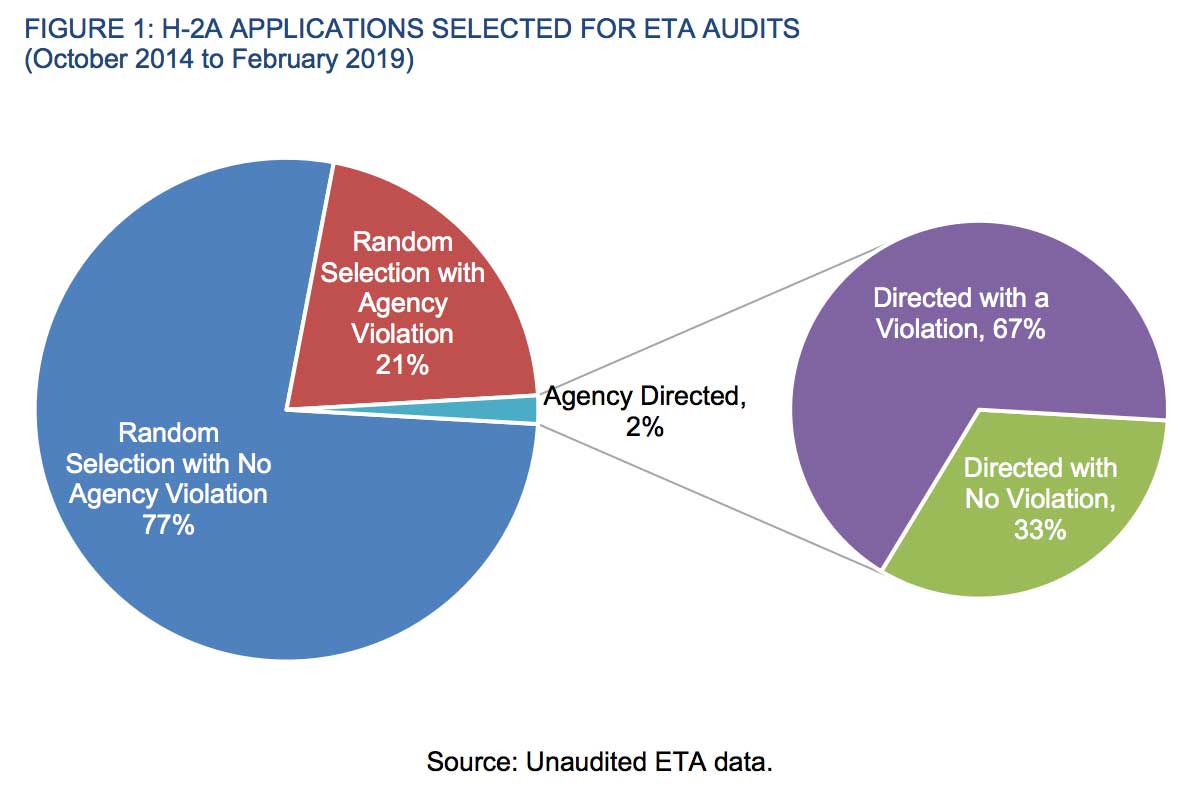The Inspector General's Office at the Department of Labor (DoL) has just issued a comprehensive, thoughtful, and devastating report on how the department handles four large foreign worker programs, titled "ETA/WHD: Overview of Vulnerabilities and Challenges in Foreign Labor Certification Programs".
These are the processes by which a minority of the temporary workers move onto permanent status (PERM), and the three temporary worker programs for skilled workers (H-1B), for farm workers (H-2A), and for non-ag, unskilled workers, often landscapers (H-2B).
While largely written in the careful — color it grey — terminology of government reports, this one includes these sentences on its third page: "The PERM program relentlessly has employers not complying with the qualifying criteria. Therefore, the PERM and H-1B programs remain highly susceptible to fraud." (Emphasis added.)
The use of these vigorous adverbs is indicative of the tone of the whole report, a welcome development.
The report has a number of solid recommendations that can, apparently, be implemented without legislation. One of them relates to a DoL decision of several years ago to accept attestations of wages and working conditions without documenting them in many cases. When documentation was required, it brought about a tighter program. For instance, on p. 6:
As a result of supporting documentation needed to verify the information on the PERM application, ETA [the Employment and Training Administration] was able to deny 21 percent of the PERM applications compared to the 3 percent of the applications denied through reviews without supporting documentation.
As an example of fraud in the PERM program, which can be avoided through demands for documentation, the report cited this on p. 9:
For example, a Virginia-based attorney prepared and submitted fraudulent applications for permanent employment certification to DOL on behalf of foreign nationals in exchange for a fee: approximately $7,500 if the foreign national already had a sponsor, and approximately $65,000 if a fraudulent sponsor needed to be arranged.
The report (p. 18) also dinged the department for the planning of site visits in the H-2A program; when it used a random sampling approach it found violations 21 percent of the time, but when they were "Agency directed" (presumably related to tips) they found violations in 67 percent of the cases, as the figure below shows.
 |
The report made this observation about the H-1B program:
As long as H-1B applications are complete and free of obvious errors or inaccuracies, ETA's role continues to be limited to simply rubber-stamping during the application certification process (previously reported).
"Previously reported" indicates that the IG noted this problem in an earlier report, but that its recommendation has been ignored by the department.
The IG explained that it had reviewed four of the department's six foreign worker programs; deleted from the list were the D-1 crewmembers program (for aliens involved with ships or planes) on the sensible grounds that it had only 24 applications since 2012, and the CW-1 Transitional Worker program in the Commonwealth of the Northern Marianas, on the basis of its recency — it went into effect on April 4, 2019. That program, given what we know about the extensive use and abuse of foreign workers in the Marianas, should be high on the IG's current "to do" list.
Caveats. While the new IG report is blessing, generally, there are two mild grumbles.
In the first place, the report deals with the four programs as largely DoL operations, when, in fact, two other cabinet agencies are heavily involved, the Departments of Homeland Security and State. DHS also has responsibilities as to who gets these jobs, including the lottery system by which they are distributed when there are more applications than the ceilings allow, and State is supposed to make sure that the individual workers are qualified for visas. The roles of the other agencies are barely mentioned
For example, the report notes that DoL deals with the odd fact that labor certification applications for the H-1B program do not even include the names of the workers to be hired; this is true, but the other two departments do have these names when H-1B decisions are made. In other words, there is a (perhaps inevitable) silo problem here.
Secondly, the report deals with the four programs — PERM, H-1B, H-2A, and H-2B — in neither an alphabetical order nor one based on the size of the programs. Were the latter arrangement to be used, the sequence (and the implied significance) would be as shown in the table below.
Foreign Worker Programs Administered by the U.S. Department of Labor |
||
| Program Title | Worker Population Defined |
Numbers |
| H-1B | Highly skilled, temporary | About 100,000 new admissions a year; total H-1B workforce about 600,000 |
| H-2A | Farm workers, temporary | 204,000 visas in 2019, most work for six months, no ceiling |
| H-2B | Non-ag, non-skilled, temporary | 66,000 annual ceiling, often breached by government decisions |
| PERM | Primarily temporary (largely H-1B) workers made permanent resident aliens | 54,290 workers (mostly adjustments) in 2017, a typical year, plus 64,184 dependents |
|
Sources: H-1B, CIS estimates; H-2A, Cato Institute; H-2B, CIS estimates; PERM, Table 7, 2017 Yearbook of Immigration Statistics, U.S. Department of Homeland Security. |
||
By the way, the IG does not deal with the size of these programs, only how they should be regulated.
The PERM program is really not part of an initial screening process. Most of the workers involved are not new to the country; they have been doing this work for these employers for years, if not decades, usually as H-1Bs. What is happening to them in PERM, and this is a slow process, is that they are being converted from temporary to permanent status. The jobs they hold currently have long since been taken away from the U.S. labor force.
